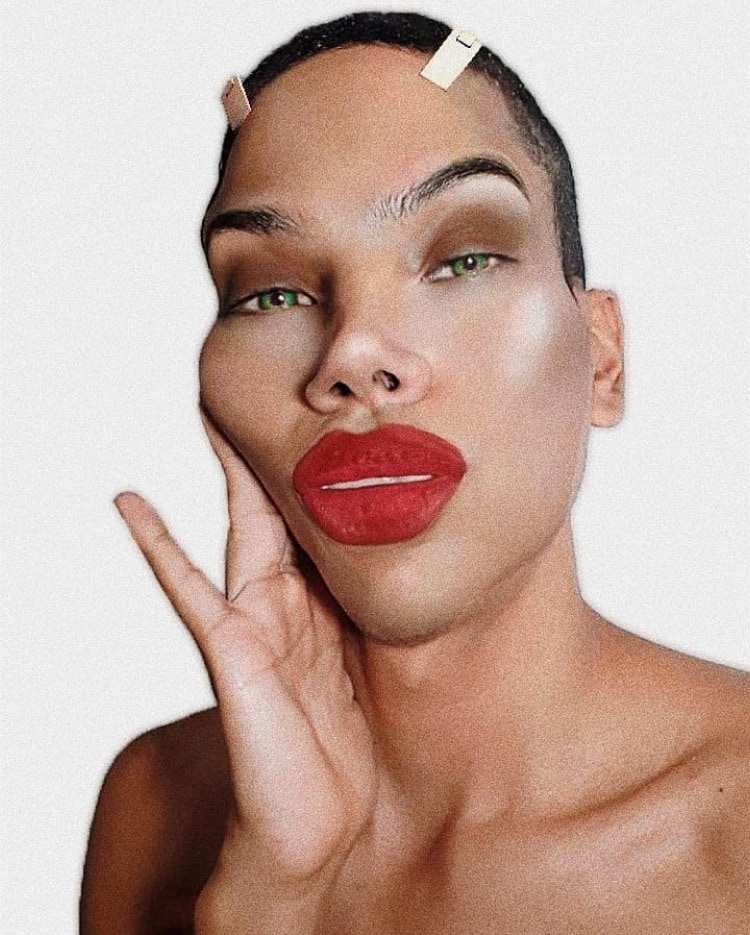

Tell us a bit about yourself, your background and what you do.
I am an Italian-born, London-based creative director specialising in 3D design and animation. In 2019, I graduated from UAL, BA (Hons) Creative Direction for Fashion. I immediately began freelancing for creative studios around London with a partner. I have also had the opportunity to speak on several panel talks and interviews, where I’ve discussed self-representation online and ethics of working digitally for online platforms. I currently work as a director with Ammolite Inc., which I’m extremely excited about as they’re truly an amazing company.
What does AR Beauty mean, especially given the context of the face-filter fad?
AR Beauty can take on many forms and meanings. I’d loosely define it as a general play with looks in an interactive, rapidly accessible, and impermanent way. Certain creators like the amazing @ines.alpha play with digital make-up rather than with facial features, which is also a form of AR beauty.
The filters were inspired by some Italian celebrities with botched surgery, who I grew up watching on TV, as well as by prosthetic make-up
Tell us about a few of your Instagram story face-filters, such as ‘Plastica,’ which garnered over 170 million uses on Instagram stories in less than a month. Why is instant access to our own (or imposed) visual aspirations so addicting?
The filters were inspired by some Italian celebrities with botched surgery, who I grew up watching on TV, as well as by prosthetic make-up. My original intent with Plastica was to create an even more exaggerated look, but Instagram AR software wouldn’t support it as the geometry was too complex, so I had to scale everything down. That was a blessing in disguise, as it made the filter go from borderline-creepy to something more accessible to mainstream taste, and eventually popular.

Anyone with access to a digital tool (whether it be a television, smartphone, social media, etc.) is constantly bombarded with specific portrayals of women. This certainly does make it easier to understand the appeal of these filters, but I don’t think it’s necessarily a bad thing — I’ve personally always enjoyed it and have taken interest in those kinds of looks. Filters are quick, noncommittal ways to try on looks that many of us have entertained ideas of how they’d work on us — if not with serious intentions, at least for fun.
It should also be noted that the media has pushed for decades towards unification of user and consumer taste, which is what makes the filter so addictive. Most online users have come to appreciate certain beauty standards and have unconsciously internalised the equation: “look = social status.” The constant availability and access to this idea is what makes these filters popular. Not necessarily the look alone, but all the unspoken notions associated with the looks.
Filters are quick, noncommittal ways to try on looks that many of us have entertained ideas of — if not with serious intentions, at least for fun
What other shifts have we seen in popular visual trends and notions of beauty and perfection as a result of incorporating augmented reality into our own self-improvement ventures?
I think since Instagram AR software became widely available, many creatives have tried to work within popular trends relating to micro plastic surgery, which has helped lead to this filter craze. I don’t necessarily believe filters are shaping notions of beauty — in fact, I think it’s actually the opposite.

The strive for social media fame seems to have killed the range and diversity of filters — we can see this phenomenon in the fact that, in the hopes of generating more followers, many face-filter creators are now creating within an increasingly hegemonic, particular visual standard. It’s not surprising that some of the most frequently asked questions in the Instagram support forum (managed by Facebook) are “how do I get followers?” and “how do I make my filters popular?”
I also believe Instagram’s decision to remove plastic surgery filters aided to the consolidation of this standard, as it failed to distinguish between filters that carry a narrative behind them and purely commercial works. For example, lip-enhancing filters continue to be approved, which makes me wonder if lip-enhancement has become culturally standard to such an extent that it’s no longer considered actual plastic surgery.
The strive for social media fame seems to have killed the range and diversity of filters
Personally, I have always perceived filters as more than just a look. Within my creation of ‘Plastica’ and ‘Princess’ Carolyn (in addition to several others that were never approved), I have always tried to tell stories through looks. I understand concerns about plastic surgery-related filters having long-lasting effects on users. But I would argue that these filters are just results of a long-established and heavily embedded social media culture which we, as users, have been building over the past decades.
I don’t believe filters alone would change social media users’ beauty ideals. There is far worse content that a 13 year-old could come across on Instagram than a face filter, which is really only projecting the culture already embedded in the mentality of the new generation.

What are you working on now? Which ‘limits’ of the body and technology are on the horizon to be explored?
My filters have given me visibility on Instagram, which have led me to land amazing opportunities as a creative director and 3D designer. We are currently working on some exciting projects with Ammolite Inc. which break the boundaries between physical and digital.
I am also working with an amazing fashion designer to make pieces of fashion digital and instantly wearable. I think this really is the first step towards merging these two realms — the physical and digital — on an even larger scale. It’s so exciting to see how these two realities can be blended so smoothly.


